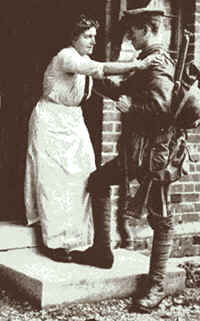Life in the Infantry
During World War One, the typical infantryman could expect just a short period of basic training - including drill and shooting practice - before they were considered ready for war.
Those soldiers travelling from the South of England were usually sent to Salisbury Plain for the final part of their training, while drills were carried out at local barracks before they were shipped out to France or Belgium.
During the training that took place on Salisbury Plain, soldiers had the chance to prove themselves worthy of a place in a specialised team. Infantry who scored over a certain number of points during their rifle work marksmanship tests would be offered the choice of becoming a sniper or joining a Lewis Machine Gun team member.
Those who proved more skilled as a marksman would also gain a badge with crossed rifles, which would indicate their skill and would allow them an extra 6d a day.
Those who were given the chance to join the a Lewis gun team would be given a badge featuring the letters ‘LG’. But in spite of its status, this was nicknamed by those in the trenches as the ‘suicide badge’ as it was believed that if Germans were to capture badge holders they would shoot them immediately due to the devastation caused by the Lewis machine gun. Those who joined a gun team as a Number 1 or Number 2 (those who carried the gun and spare parts) were also asked to hand in their Lee Enfield rifle as it was considered a hindrance. Instead, they went to the front line with a Webley revolver.

Lewis machine gun teams would be made up of five men, who would all be tasked with defending the trench lines. This meant they were not expected to conduct the normal duties of the infantrymen, such as cleaning the latrines, as their failure to protect the trenches would result in the trench system becoming overrun with Germans. The Lewis gun team also had to dedicate a large amount of time to keeping their gun clean and in good working order, as an issue during a German attack could result in death for their regiment.
A Lewis crew’s Number 1 was given responsibility for leading the group and would carry the gun from post to post. The Number 2 would carry the spare parts. Each of these men would have to carry around three stones in wright, which is why a rifle would have been such a hindrance. The other three men in the Lewis crew were expected to carry around two hundred rounds of ammunition in panniers.
Being in charge, Number 1 would have the final say on where the gun was placed, but they would move frequently so as to avoid being targeted by artillery.

For infantrymen in general, life in the trenches was muddy, unsanitary and hard work. Those fighting in Ypres and Passchendaele regularly wrote letters describing the difficulties they had finding fresh water; while the commanders did provide water, it was often transported in petrol cans and so tasted and smelt of petrol. This issue regularly brought the infantrymen into conflict with local farmers, who feared that they would empty their wells and prevent them from hydrating their crops and livestock.
Harry Patch, a survivor of Passendaele, provided one of the best insights historians have into the conditions in the trenches, describing them as “lousy, dirty and unsanitary”. According to Harry and his comrades, rats were one of the biggest problem facing those on the front lines, often nibbling at the faces of the soldiers as they slept. Lice were also a constant source of stress for the soldiers, who had to use candles to burn them from their uniforms each day. Although it’s fair to say that this was one of an almost infinite number of problems that were faced by the average infantryman on a daily basis during World War One.
MLA Citation/Reference
"Life in the Infantry". HistoryLearning.com. 2026. Web.
